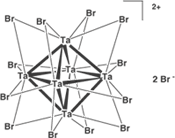
The very electron-rich Tantalum Bromide Cluster induces significant changes in crystal diffraction required for convenient phase calculation in single and multiple isomorphous replacement (SIR and MIR) experiments and in anomalous dispersion (SAD and MAD) experiments.
The two present anomalous scatterers Ta and Br are useful for determining the cluster orientation for low resolution datasets.
Tantalum Bromide Clusters have been successfully employed in several structural studies because of their high electron-density, solubility in aqueous solutions and stability over a wide pH range.